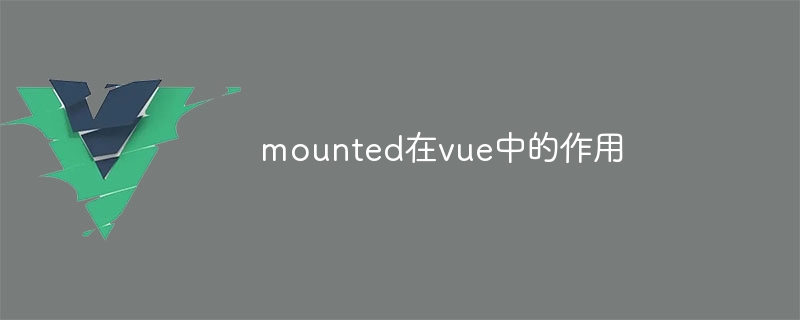The role of mounted in vue
mounted is a life cycle hook function in Vue.js, which is triggered immediately after the component is successfully loaded for the first time and inserted into the DOM tree. The functions it provides include: initializing data and status calling API or service binding event listener manipulating DOM setting focus performing other initialization tasks

##mounted Its role in Vue
mounted is a life cycle hook function in Vue.js, which is triggered immediately after the component is successfully loaded for the first time and inserted into the DOM tree. It provides access to DOM nodes, allowing them to perform specific operations after the component is mounted.
Function:
- Initialize data and status: You can initialize the data and status of the component to ensure that when the component is mounted in the desired state.
- Call API or service: You can call API or service and obtain the necessary data after the component is mounted.
- Bind event listeners: Event listeners can be bound to DOM elements to trigger specific methods when the user interacts.
- Manipulate DOM: You can directly manipulate DOM nodes, such as adding, deleting or modifying elements.
- Set focus: You can set the focus of an element in the component.
- Perform other initialization tasks: You can perform any other initialization tasks that need to be performed after the component is mounted.
Usage:
In themounted function of the component, you can perform the required operations as follows:
mounted() {
// 初始化数据和状态
this.data = { ... };
// 调用 API
fetch('/api/data')
.then(res => this.data = res.data)
.catch(err => console.error(err));
// 绑定事件侦听器
this.$el.addEventListener('click', this.handleClick);
// 操作 DOM
this.$el.classList.add('active');
// 设置焦点
this.$el.querySelector('input').focus();
// 其他初始化任务
console.log('Component mounted!');
}Note:
- mounted
The hook function is only triggered when the component is mounted for the first time. If the component is later unmounted and remounted, it will not be triggered again. - mounted
The hook function cannot modify the component's props because the props have been set before the component is created.
The above is the detailed content of The role of mounted in vue. For more information, please follow other related articles on the PHP Chinese website!

Hot AI Tools

Undresser.AI Undress
AI-powered app for creating realistic nude photos

AI Clothes Remover
Online AI tool for removing clothes from photos.

Undress AI Tool
Undress images for free

Clothoff.io
AI clothes remover

Video Face Swap
Swap faces in any video effortlessly with our completely free AI face swap tool!

Hot Article

Hot Tools

Notepad++7.3.1
Easy-to-use and free code editor

SublimeText3 Chinese version
Chinese version, very easy to use

Zend Studio 13.0.1
Powerful PHP integrated development environment

Dreamweaver CS6
Visual web development tools

SublimeText3 Mac version
God-level code editing software (SublimeText3)

Hot Topics
 How to use bootstrap in vue
Apr 07, 2025 pm 11:33 PM
How to use bootstrap in vue
Apr 07, 2025 pm 11:33 PM
Using Bootstrap in Vue.js is divided into five steps: Install Bootstrap. Import Bootstrap in main.js. Use the Bootstrap component directly in the template. Optional: Custom style. Optional: Use plug-ins.
 How to add functions to buttons for vue
Apr 08, 2025 am 08:51 AM
How to add functions to buttons for vue
Apr 08, 2025 am 08:51 AM
You can add a function to the Vue button by binding the button in the HTML template to a method. Define the method and write function logic in the Vue instance.
 How to use watch in vue
Apr 07, 2025 pm 11:36 PM
How to use watch in vue
Apr 07, 2025 pm 11:36 PM
The watch option in Vue.js allows developers to listen for changes in specific data. When the data changes, watch triggers a callback function to perform update views or other tasks. Its configuration options include immediate, which specifies whether to execute a callback immediately, and deep, which specifies whether to recursively listen to changes to objects or arrays.
 What does vue multi-page development mean?
Apr 07, 2025 pm 11:57 PM
What does vue multi-page development mean?
Apr 07, 2025 pm 11:57 PM
Vue multi-page development is a way to build applications using the Vue.js framework, where the application is divided into separate pages: Code Maintenance: Splitting the application into multiple pages can make the code easier to manage and maintain. Modularity: Each page can be used as a separate module for easy reuse and replacement. Simple routing: Navigation between pages can be managed through simple routing configuration. SEO Optimization: Each page has its own URL, which helps SEO.
 How to reference js file with vue.js
Apr 07, 2025 pm 11:27 PM
How to reference js file with vue.js
Apr 07, 2025 pm 11:27 PM
There are three ways to refer to JS files in Vue.js: directly specify the path using the <script> tag;; dynamic import using the mounted() lifecycle hook; and importing through the Vuex state management library.
 How to return to previous page by vue
Apr 07, 2025 pm 11:30 PM
How to return to previous page by vue
Apr 07, 2025 pm 11:30 PM
Vue.js has four methods to return to the previous page: $router.go(-1)$router.back() uses <router-link to="/" component window.history.back(), and the method selection depends on the scene.
 How to use vue traversal
Apr 07, 2025 pm 11:48 PM
How to use vue traversal
Apr 07, 2025 pm 11:48 PM
There are three common methods for Vue.js to traverse arrays and objects: the v-for directive is used to traverse each element and render templates; the v-bind directive can be used with v-for to dynamically set attribute values for each element; and the .map method can convert array elements into new arrays.
 How to jump to the div of vue
Apr 08, 2025 am 09:18 AM
How to jump to the div of vue
Apr 08, 2025 am 09:18 AM
There are two ways to jump div elements in Vue: use Vue Router and add router-link component. Add the @click event listener and call this.$router.push() method to jump.






